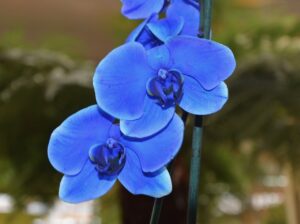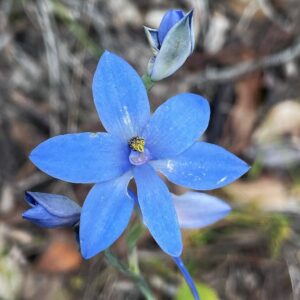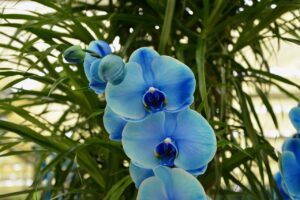Check out the best Rare Types of Blue Orchids in this exclusive list. Explore Unique Varieties & the Fascinating Spectrum of Blue Hues.
Discover the best Rare Types of Blue Orchids. These unique and uncommon varieties showcase captivating shades of blue, offering a glimpse into the extraordinary diversity of the orchid family. Explore the beauty and rarity of these stunning blooms.
Read Benefits of Using Lemon Juice for Orchids
Are There True Blue Orchids Exist?

Are There True Blue Orchids Exist? The answer is both yes and no.
There are very few kinds of orchids that are actually blue in color, but they do exist. Most of them are very rare, which means you won’t find them at your nearby plant store – you might not even see them ever. One of these types is a bit easier to find than the other, but it’s still really hard to find and needs a lot of care.
Read Find Does Walmart Sell Flowers?
Are Blue Orchids Fake or Real?
If you want a natural orchid that’s truly blue, there aren’t many options. But there are fake ones available that get a dark blue color by putting special coloring into them.
The White Phalaenopsis Orchid is used to make orchids blue. They put dye into the plant, and it turns really blue.
But remember, this only happens once. The next flowers that come out will be white again.
Read Everything About Sweet Potato Flowers and Their Uses
Making of the Blue-Flowered Phalaenopsis
The artificial blue-colored phalaenopsis orchid was first presented in 2011. It’s a modification of the common white-flowered orchid known as P. amabilis. Certain companies produce these modified orchids by injecting patented dye solutions into the spike of the flowers after they’ve bloomed. This process gives the orchids an electric blue color. The shade of blue can vary based on when the dye is injected.
Injecting dye before the flowers fully open results in a deeper color. While injecting it when the flowers are still in the bud stage leads to lighter blue hues.
Blue isn’t a usual flower color; less than ten percent of recognized flowering plants exhibit the blue spectrum on the color wheel. Even when plants are described as having blue flowers, they often appear more in shades of purple or lavender.
Efforts by botanists and horticulturists to genetically alter plants for blue blooms have mostly been unsuccessful. However, some blue-flowered phalaenopsis orchids were showcased at an orchid exhibition in Japan in 2013. These orchids were reportedly genetically modified and patented. But they haven’t become available in the orchid market yet, and they’re not the same as the blue phalaenopsis orchids sold by local retailers.
Find Out Are Pansies Edible
Types of Blue Orchids
1. The Blue Lady Orchid
Botanical Name: Thelymitra crinita

Originating from the southwest regions of Western Australia, the blue lady orchid (Thelymitra crinita) is a terrestrial species categorized within the sun orchid group. These orchids are known to bloom after being exposed to increased sunlight. The Thelymitra genus comprises approximately 80 species of terrestrial tuberous orchids native to parts of Australia, New Zealand, and nearby islands. They usually inhabit regions with higher rainfall in their native territories, often found in partly shaded forests and scrublands.
The appearance of the blue lady orchid might not immediately resemble the typical orchid archetype. The sepals and lateral petals bear a similar size, shape, and color, while the labellum stands out due to its elongated, narrower structure. The flowers showcase a striking, intense blue color. The orchid’s column is also blue with a yellow crest.
This plant produces a solitary leaf measuring 2-6 inches in length. The leaf emerges from the plant’s base and grows in an arching manner. Generally, an upright to arching stem, ranging from 8 to 30 inches in height, carries 2-15 flowers that are 1-2 inches wide.
2. The Blue Aganisia Orchid
Botanical Name: Aganisia cyanea
Native to tropical regions of Brazil, Venezuela, and Colombia at elevations between 300 and 1,500 feet, the blue aganisia orchid (Aganisia cyanea) is an orchid that thrives in warm environments. Unlike many other orchids, it can tolerate more moisture due to its epiphytic nature. Found in its home habitat, this orchid often faces flooding from the Amazon River, with only its flowers staying above water. It’s also known as Acacallis cyanea and is one of just four species in the Aganisia genus.
The orchid’s appearance is understated and delicate. The outer petals, or sepals, are pale blue with some darker blue along the top’s wavy edges. The two inner petals, or lateral petals, match the dorsal sepal’s color and have similar wavy edges. The labellum, which is the modified lower petal or lip, is a darker blue-purple and shaped like outward-folding wings.
The leaves of this orchid are glossy, light green, and ovate-to-elliptical in shape, with smooth edges. Blooming takes place from late winter through late spring, producing 2.5-inch wide flowers that come in clusters of 3 to 10. These flowers grow atop an upright, bare raceme that reaches 10 to 12 inches in height.
3. The Blue Vanda Orchid
Botanical Name: Vanda coerulea

Originating from cooler regions of India, Myanmar, and Thailand, this orchid is an evergreen, epiphytic plant that grows on tree bark in open woodlands at elevations of approximately 2600-5600 feet. It’s recognized as one of the few “true blues” within the Orchidaceae family.
Displaying captivating blue flowers, this orchid showcases an outer circle of sizeable rounded sepals that are densely marked with a blue and white pattern. The dorsal sepal is usually slightly smaller than the lateral sepals. The lateral petals resemble the dorsal sepal in size, color, and shape. The labellum of this species is relatively small and possesses a v-shaped, blue-purple lip.
The plant produces around 20 evergreen, elongated, blade-like leaves that appear in an alternating manner as they climb up a thick stem. These leaves can vary in length from 3 to 10 inches and are generally about an inch wide. During the fall, flowers measuring 4 to 6 inches wide blossom emerging near the top of a branching, bare stem.
When Do Sunflowers Bloom in Texas? Find Out
How to Grow and Care for Blue Orchids?

Growing blue orchids follows a similar process to growing standard orchids, with only a few small distinctions that require attention.
Light
The blue orchids need a lot of light. It should get strong, indirect light or full morning sun, then filtered light. The leaves should be light green; if they’re dark green, it means they’re not getting enough sunlight.
Soil
You can grow blue orchids in a pot using a mixture of tree fern, charcoal, and perlite. Another option is to attach it to tree fern slabs. If you choose the slab method, keep an eye on watering, as you might need to water more frequently or mist the plant to prevent the roots from drying out too quickly.
Watering
In spring and summer, water regularly to keep the roots from drying out. As fall comes, begin to decrease the amount of watering. During winter, water sparingly and only when necessary.
Temperature and Humidity
For best results, aim for summer daytime temperatures from 75 to 85 degrees Fahrenheit and nighttime temperatures of 60 to 65 degrees. In winter, keep the daytime temperatures between 70 and 75 degrees and nighttime temperatures between 45 and 50 degrees Fahrenheit.
In its natural habitat, the blue vanda orchid experiences humidity of around 80-85% during the summer and about 50-55% during the drier winter months.
Fertilizer
When it’s growing, feed it a diluted orchid fertilizer every week, using only a quarter of the recommended strength. To promote fall blooms by mid-summer, switch to a fertilizer with more phosphorus and less nitrogen. In the winter, reduce feeding to around once a month.
Find Unique Plants and Flowers That Look Like Lips
FAQs
Q.1. Are dyed flowers on orchids rare?
The method was initially introduced in 2011 and has since gained traction. You can easily find artificially-dyed orchids in grocery stores, large retail stores, gardening centers, and online.
Q.2. Are artificially dyed orchids toxic?
The dyes are water-based, and although certain growers opt for food-grade coloring, the complete list of dye ingredients remains unknown.
Q.3. Can I grow blue orchids at home naturally?
Growing naturally blue orchids at home can be challenging. While some orchid species do have naturally blue flowers, they often require specific conditions and care that may be difficult to replicate indoors.
Q. 4. Are blue orchids available year-round?
Blue orchids, whether natural or artificially colored, are generally available year-round due to advancements in cultivation techniques and dyeing processes.
Check Common Toxic Flowers



